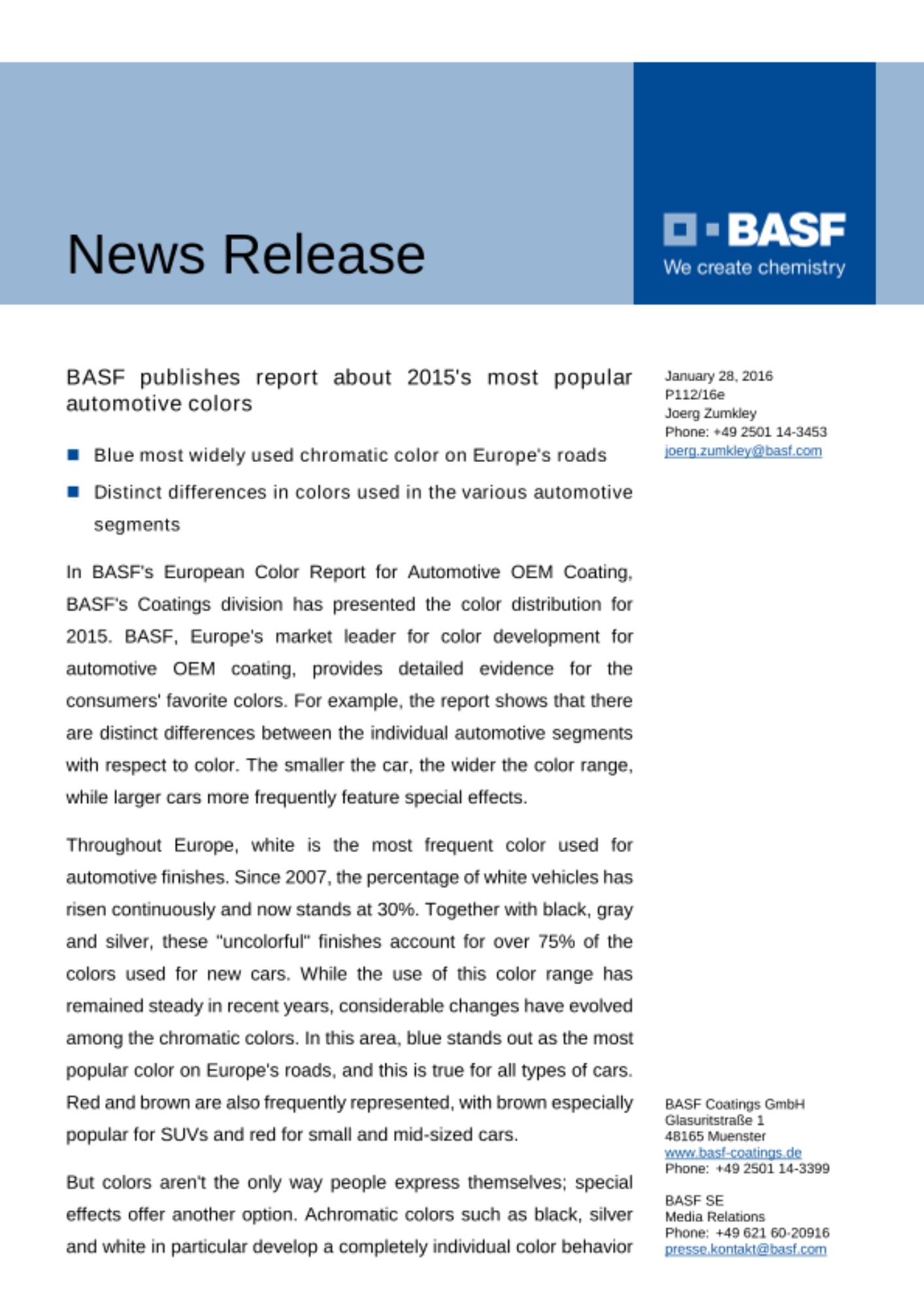Münster
BASF publishes report about 2015's most popular automotive colors
- Blue most widely used chromatic color on Europe's roads
- Distinct differences in colors used in the various automotive segments
In BASF's European Color Report for Automotive OEM Coating, BASF's Coatings division has presented the color distribution for 2015. BASF, Europe's market leader for color development for automotive OEM coating, provides detailed evidence for the consumers' favorite colors. For example, the report shows that there are distinct differences between the individual automotive segments with respect to color. The smaller the car, the wider the color range, while larger cars more frequently feature special effects.
Throughout Europe, white is the most frequent color used for automotive finishes. Since 2007, the percentage of white vehicles has risen continuously and now stands at 30%. Together with black, gray and silver, these "uncolorful" finishes account for over 75% of the colors used for new cars. While the use of this color range has remained steady in recent years, considerable changes have evolved among the chromatic colors. In this area, blue stands out as the most popular color on Europe's roads, and this is true for all types of cars. Red and brown are also frequently represented, with brown especially popular for SUVs and red for small and mid-sized cars.
But colors aren't the only way people express themselves; special effects offer another option. Achromatic colors such as black, silver and white in particular develop a completely individual color behavior through targeted special effects. The geometry of the body is visually enhanced and the colors take on a new effect, as Mark Gutjahr, head of Automotive OEM Color Design at BASF in Europe points out. "The targeted interaction between color and special effects is making automotive colors more complex and multifaceted. This development will continue to accompany us for a few years. We haven't yet exhausted the possibilities in the special-effect palette." In 2015, more than half of all cars throughout Europe were coated with luxury paints with metallic effects and 16% featured pearl effects. Nearly one in three cars has a pure solid finish, mostly in the small car segment.
With the analysis of the current color distribution in the European automotive market, BASF's European Color Report supplements the facts contained in the Color Trend Collection published annually by BASF's Coatings division. While the trend collection provides an outlook on the color areas that will play a role for cars in the future, the report reflects market development and summarizes the status quo.
» Download BASF European Color Report for Automotive OEM Coating
About BASF’s Coatings division
BASF’s Coatings division develops, produces and markets innovative automotive coatings, automotive refinishes and industrial coatings as well as decorative paints. We operate sites in Europe, North America and South America as well as Asia Pacific. Within this network, we collaborate closely with our customers all over the world. In 2014, the Coatings division achieved global sales of about €3 billion. More information about the division is available at www.basf-coatings.com.
About BASF
At BASF, we create chemistry – and have been doing so for 150 years. Our portfolio ranges from chemicals, plastics, performance products and crop protection products to oil and gas. As the world’s leading chemical company, we combine economic success with environmental protection and social responsibility. Through science and innovation, we enable our customers in nearly every industry to meet the current and future needs of society. Our products and solutions contribute to conserving resources, ensuring nutrition and improving quality of life. We have summed up this contribution in our corporate purpose: We create chemistry for a sustainable future. BASF had sales of over €74 billion in 2014 and around 113,000 employees as of the end of the year. BASF shares are traded on the stock exchanges in Frankfurt (BAS), London (BFA) and Zurich (AN). Further information on BASF is available on the Internet at www.basf.com.
P-16-112


